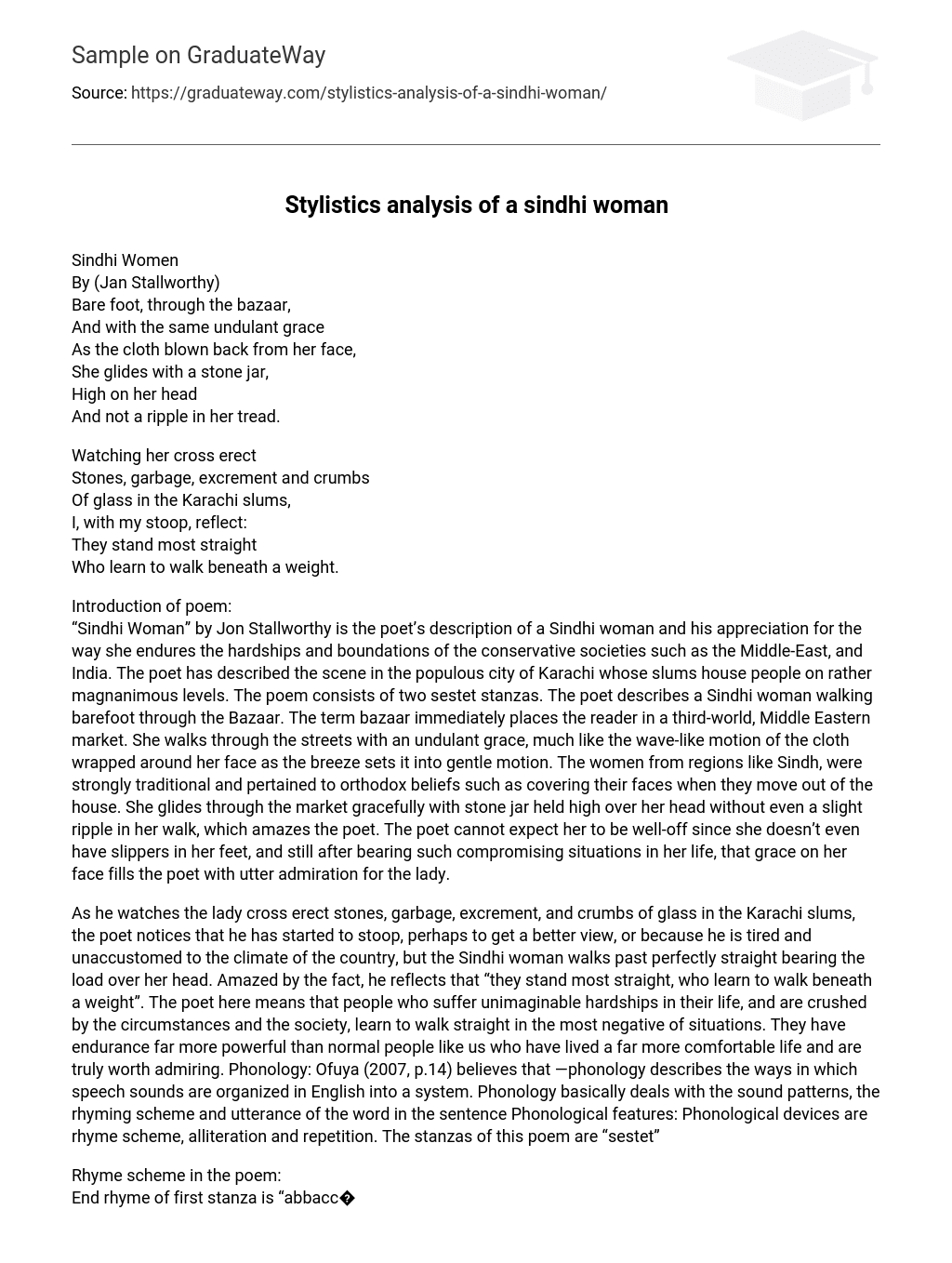Sindhi Women
By (Jan Stallworthy)
Bare foot, through the bazaar,
And with the same undulant grace
As the cloth blown back from her face,
She glides with a stone jar,
High on her head
And not a ripple in her tread.
Watching her cross erect
Stones, garbage, excrement and crumbs
Of glass in the Karachi slums,
I, with my stoop, reflect:
They stand most straight
Who learn to walk beneath a weight.
Introduction of poem:
“Sindhi Woman” by Jon Stallworthy is the poet’s description of a Sindhi woman and his appreciation for the way she endures the hardships and boundations of the conservative societies such as the Middle-East, and India. The poet has described the scene in the populous city of Karachi whose slums house people on rather magnanimous levels. The poem consists of two sestet stanzas. The poet describes a Sindhi woman walking barefoot through the Bazaar. The term bazaar immediately places the reader in a third-world, Middle Eastern market. She walks through the streets with an undulant grace, much like the wave-like motion of the cloth wrapped around her face as the breeze sets it into gentle motion. The women from regions like Sindh, were strongly traditional and pertained to orthodox beliefs such as covering their faces when they move out of the house. She glides through the market gracefully with stone jar held high over her head without even a slight ripple in her walk, which amazes the poet. The poet cannot expect her to be well-off since she doesn’t even have slippers in her feet, and still after bearing such compromising situations in her life, that grace on her face fills the poet with utter admiration for the lady.
As he watches the lady cross erect stones, garbage, excrement, and crumbs of glass in the Karachi slums, the poet notices that he has started to stoop, perhaps to get a better view, or because he is tired and unaccustomed to the climate of the country, but the Sindhi woman walks past perfectly straight bearing the load over her head. Amazed by the fact, he reflects that “they stand most straight, who learn to walk beneath a weight”. The poet here means that people who suffer unimaginable hardships in their life, and are crushed by the circumstances and the society, learn to walk straight in the most negative of situations. They have endurance far more powerful than normal people like us who have lived a far more comfortable life and are truly worth admiring. Phonology: Ofuya (2007, p.14) believes that ―phonology describes the ways in which speech sounds are organized in English into a system. Phonology basically deals with the sound patterns, the rhyming scheme and utterance of the word in the sentence Phonological features: Phonological devices are rhyme scheme, alliteration and repetition. The stanzas of this poem are “sestet”
Rhyme scheme in the poem:
End rhyme of first stanza is “abbacc”
End rhyme of second stanza is “deedff”
Rhyme scheme in the poem is as follows:
1. Bazaar, jar
2. Grace, face
3. Head, tread
4. Erect, reflect
5. Crumbs, slums
6. Straight, weight
Alliteration:
Bare, Bazar in line “1”
Bloom, back in line “3”
High, head in line “5”
Stand, straight in line “11”
Walk, weight in line “12”
Repetition:
“The” is used 3 times in poem.
“And” is used 3 times in poem.
With the use of rhyme scheme, alliteration and repetition poet makes poem more attractive and beautiful. In other words we can say that these are the ornaments of poetry. Graphology: Graphology refers to the whole writing system: punctuation and paragraphing as well as spacing. According to Crystal and Davy (1969, p.18) ―Graphology is the analogous study of a languages writing system. These are the formalized rules of writing. Alabi (2007, p.170) added that “a graphological discussion of style among other features entails the foregrounding of quotation marks, ellipses periods, hyphens, contracted forms, special structures, the full stop, the colon, the comma, the semicolon, the question mark, the dash, lower case letters, gothic and bold prints, capitalization, small print, spacing, italics etc”. In other words, it deals with the systematic formation, structure and punctuation in the sentence. Graphological Feature: In this poem poet uses full stop (.) two times at the end of both sestets. It means that one line ends at end of one stanza. Poet uses comas (,) in most of times and also uses hyphen (:) in second stanza.
Lexical features:
Noun
Verb
Adjective
Foot
Walk
Bare
bazar
Stand
High
Grace
Stoop
Most
Cloth
Reflect
beneath
Face
Watching
Stone
Cross
Jar
Erect
Head
Tread
High
Ripple
Ripple
Glide
Garbage
Blown
Excrement
through
Glass
Karachi
slums
weight
Total=16
Total=12
Total=4
Analysis Conclusion: A Sindh Woman by Jan Stallworthy consists of two sestet stanzas and having rhyme scheme “abbacc” in first and “cddcff” in second stanza both are same. The vocabulary of poem is not too much difficult. It is easily understandable. Poet uses beautiful rhyme scheme and stress, unstress pattern which causes unique rhythm in poem. Poet uses rich amount of nouns in poem. In semantic deviations poet talk the current situation of Karachi and showing the picture of its streets as well as the duty of Sindhi women. There is a Urdu word “bazaar” poet uses once. Findings:
The poem sindhi woman describes the condition of Karachi streets and duty of Sindhi women. StallWorthy points out which kind of things she has to move over bare foot. StallWorthy explains this through his style by the variations in rhythm, by the stressed pattern he followed, and by playing through words, he beautifully describes the contrast in the atmosphere and problem of her.
Conclusion:
The choice of words by the writer or the poet plays a very important role in meaning making. It helps the reader to understand the message the poet is trying to pass on. Stylistics, by this analysis has shown that there is a distinction between poetic and non- poetic language as a means of defining literature.





